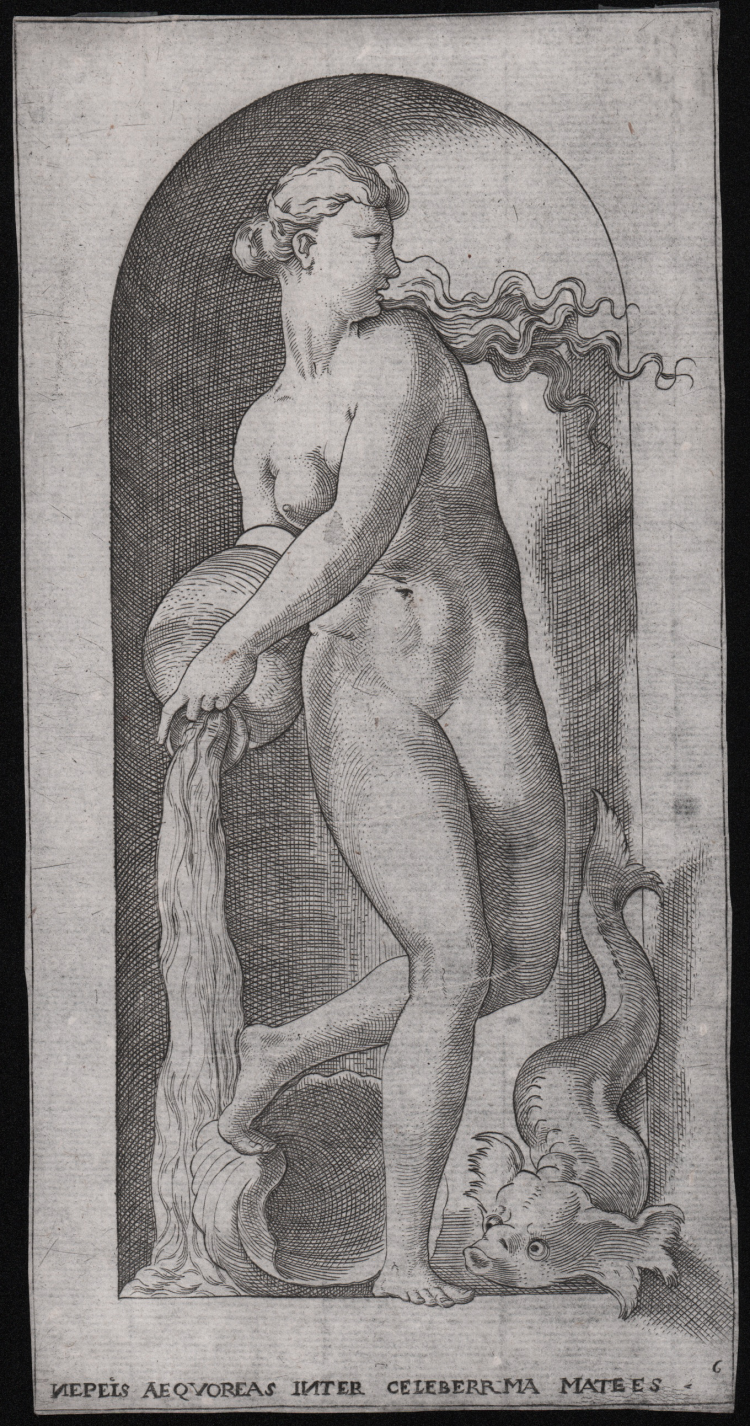



| Reference: | S32239 |
| Author | Jacob BINK |
| Year: | 1540 ca. |
| Measures: | 110 x 215 mm |


| Reference: | S32239 |
| Author | Jacob BINK |
| Year: | 1540 ca. |
| Measures: | 110 x 215 mm |
Engraving, 1540/50 circa, without printing details. Lettered along lower edge: 'NEPEIS AEQUOREAS INTER CELEBERRIMA MATEES'.
Sheet belonging to the series of 20 engravings depicting the Gods of Olympus, plate number 6, after Gian Giacomo Caraglio (1526) and based on drawings by Rosso Fiorentino.
Jacob Binck was a painter, engraver and medallist (Cologne c. 1500-Königsberg 1569). Thought to have trained in Nuremberg because he made may copies of prints after the Beham brothers, but this cannot be firmly established. He was working in the Netherlands by 1528, and was strongly influenced by the Flemish masters, especially the engraver Allaert Claesz. There he engraved several portraits. In 1531 Binck was made court painter to Christian III of Denmark, whose engraved portrait he executed in 1535. He worked briefly in Sweden on a royal commission, the portrait of King Gustav Vasa; and moved to Königsberg in 1543, summoned by Duke Albrecht of Prussia where he remained until February 1548, when he returned to the Danish court. He later visited Saxony and Antwerp, and after 1553 he seems to have lived mainly in Königsberg where he died in 1569. He produced distinguished medals of his royal and ducal patrons. Many of his prints are copied after other masters, but he nonetheless produced some some original work. Often wrongly identified with the Italian Monogrammist HCB.
Bibliografia
Hollstein, German engravings, etchings and woodcuts c.1400-1700, n. 80); Bartsch, Le Peintre graveur (VIII.273.31); Bartsch Le Peintre graveur (Caraglio, XV.78.29); Massari, Tra mito e allegoria, immagini a stampa nel ‘500 e ‘600, pp. 119-140, n. 41.
Jacob BINK (Colonia circa 1500 - Konigsberg 1569)
|
German painter, engraver and designer, active in Denmark and Sweden. While he worked as a court painter in Denmark c. 1530–50, he also served the Swedish court temporarily (1541–2) under Gustav Vasa, of whom he executed a portrait: this is untraced but is known through an old copy (Uppsala, U. Kstsaml.). Binck’s picture, according to the copy, belonged to the so-called South German portrait school, showing the King half-figure against a neutral background. It is dominated more by the mass of the body and costume than by the impassive, three-quarter-profile face. Binck’s picture has long since been widely distributed, represented on Swedish banknotes. A similar bust portrait of Christian III was engraved by Binck in 1535. Later, when he returned to Denmark from Sweden, he was influenced by the Dutch art of portraiture, with its more penetrating depiction of character. This can be seen in the portrait of the Danish chancellor Johan Friis (1550; Hillerød, Frederiksborg Slot). Woodcuts after Binck’s drawing of Christian III and the Danish state coat of arms, in a framework in the style of Cornelis Floris, were made for the Danish translation of the Bible in 1550. Binck probably collaborated on the exterior and interior decoration of Johan Friis’s castle at Hesselagergaard on Fyn, where parts of the wall paintings with battle and chivalric motifs (1549–51) have survived.
|
Jacob BINK (Colonia circa 1500 - Konigsberg 1569)
|
German painter, engraver and designer, active in Denmark and Sweden. While he worked as a court painter in Denmark c. 1530–50, he also served the Swedish court temporarily (1541–2) under Gustav Vasa, of whom he executed a portrait: this is untraced but is known through an old copy (Uppsala, U. Kstsaml.). Binck’s picture, according to the copy, belonged to the so-called South German portrait school, showing the King half-figure against a neutral background. It is dominated more by the mass of the body and costume than by the impassive, three-quarter-profile face. Binck’s picture has long since been widely distributed, represented on Swedish banknotes. A similar bust portrait of Christian III was engraved by Binck in 1535. Later, when he returned to Denmark from Sweden, he was influenced by the Dutch art of portraiture, with its more penetrating depiction of character. This can be seen in the portrait of the Danish chancellor Johan Friis (1550; Hillerød, Frederiksborg Slot). Woodcuts after Binck’s drawing of Christian III and the Danish state coat of arms, in a framework in the style of Cornelis Floris, were made for the Danish translation of the Bible in 1550. Binck probably collaborated on the exterior and interior decoration of Johan Friis’s castle at Hesselagergaard on Fyn, where parts of the wall paintings with battle and chivalric motifs (1549–51) have survived.
|